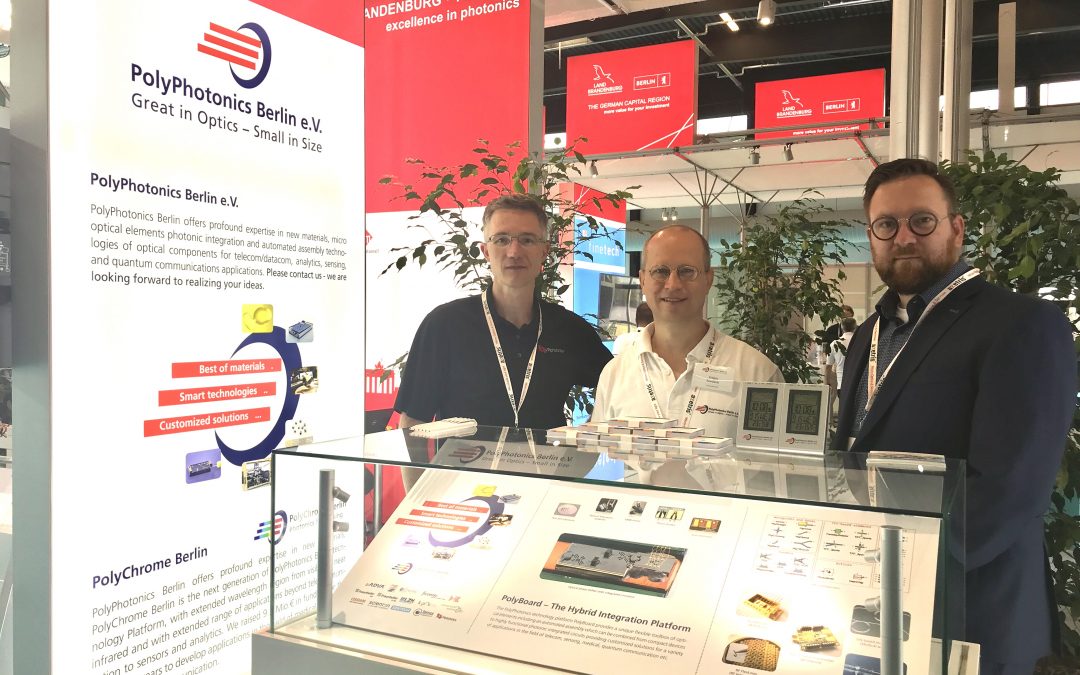
Review of the ECOC 2021
Last month the association PolyPhotonics Berlin presented its latest innovations and the new project PolyChrome Berlin at the ECOC. Here are some impressions from the booth of the PolyPhotonics Berlin e.V. association.

Last month the association PolyPhotonics Berlin presented its latest innovations and the new project PolyChrome Berlin at the ECOC. Here are some impressions from the booth of the PolyPhotonics Berlin e.V. association.
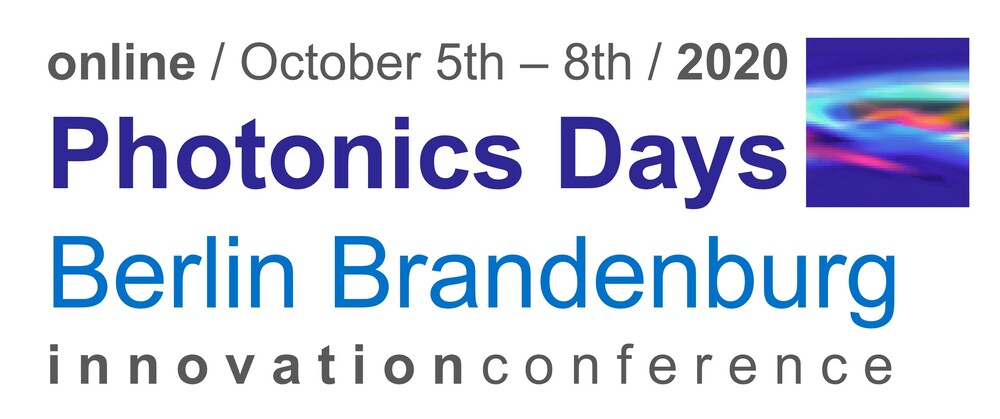
| 15:00 | PolyPhotonics e.V. | Dr. Arne SchleunitzCrispin Zawadzki | Welcome |
| Project sponsor Jülich | Dr. Stefan Schründer | The RUBIN programme within the BMBF funding initiative “Innovation and structural change” | |
| Berlin Partner | Gerrit Rössler | PolyChrome – A photonics lighthouse initiative for the Berlin cluster development policy | |
| 15:30 | Fraunhofer Heinrich Hertz Institute | Crispin Zawadzki | Hybrid Photonic Integration Platform |
| VPIphotonics | Dr. André Richter | Simulate and characterize your hybrid PIC design | |
| ADVA Optical Networking | Mirko Lawin | Rapid Precision Fiber Sensing | |
| micro resist technology | Dr. Jan Jasper Klein | Advanced polymer materials for PolyBoard technology | |
| eagleyard Photonics | Joerg Muchametow | Multi lambda source for multiple applications | |
| Allresist | Dr. Mandy Grube | Resist compositions for the fabrication of optical waveguide materials over a wide spectral range | |
| Laser Zentrum Hannover | Anna Karoline Rüsseler | Miniaturized thin-film filters | |
| OSRAM Opto Semiconductors | Dr. Hubert Halbritter | Semiconductor Laser in Photonic Applications | |
| Chembio Diagnostics | Volker Plickert | Novel POCT Devices | |
| Fraunhofer Institute for Cell Therapy and Immunology | Dr. Marcus Menger | Aptamers as specific molecular recognitions elements in biosensors | |
| Scienion | Dr. Wilfried Weigel | Biofunctionalisation of Biosensors | |
| Ficontec | Dr. Christoph v. Kopylow | Automated Massproduction on a flexible Manufacturing Platform for different Applications | |
| 18:00 | PolyPhotonics Berlin e.V. | Dr. Arne Schleunitz Crispin Zawadzki |
Closing remarks |
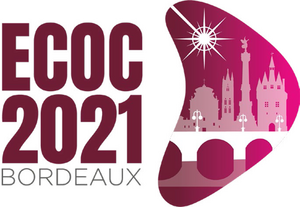
The 47th edition of ECOC will take place on September 13 – 15, 2021.
The outbreak of the global health crisis in 2020 was a worldwide eye-opener that digital infrastructure has become an essential part of everyone’s professional and personal lives. Never before has it been so clear that digital infrastructure as a whole has become an indispensable marketplace for food and goods, an enabler of our children’s education, an enabler of telecommuting, a repository of our culture, a guarantor of some of our civil liberties, and an advocate for our friends and family. Overall, COVID-19 has unleashed an intense wave of digital transformation and digital expansion, with light as the propellant.
This wave reinforces the Capital of Culture as a unique, vibrant place for global opportunities, a place to share knowledge, stimulate creativity, steer innovation, and build collaborations. At both the conference and the accompanying exhibition, companies and institutions from around the world will showcase the latest news and scientific breakthroughs from materials and devices to systems and networks. Expect to meet with analysts, media, government agencies, vendors and users – as well as peers, colleagues or customers.
After the virtual edition in Brussels in 2020, ECOC returns to France for its 47th edition, seven years after Cannes. The 2021 ECOC conference will be held together with the exhibition in the city of Bordeaux, in the heart of the wine region, less than 2 hours from most European capitals.
The PolyPhotonics Berlin association will be presenting at ECOC this year in conjunction with the Fraunhofer Heinrich Hertz Institute, HHI, which is one of the world’s leading developers of mobile and optical communication networks and systems, as well as video signal coding and data processing. At ECOC 2021, current innovations as well as the new PolyChrome Berlin project, which this year won the RUBIN funding program from the German Federal Ministry of Education and Research (BMBF), will be presented at the PolyPhotonics Berlin e.V. booth from September 13-15 in Bordeaux, France.
The association will present its PolyBoard platform, which allows hybrid integration of active and passive optical components into photonic integrated circuits. Developments include tunable lasers in the visible and infrared wavelength ranges, and thin-film filters for polarization handling and spectral filtering. Furthermore, the PolyBoard platform’s micro-optical bench enables hybrid integration of optical isolators and circulators, as well as nonlinear crystals for applications in quantum optics.
More information about the event can be found at:
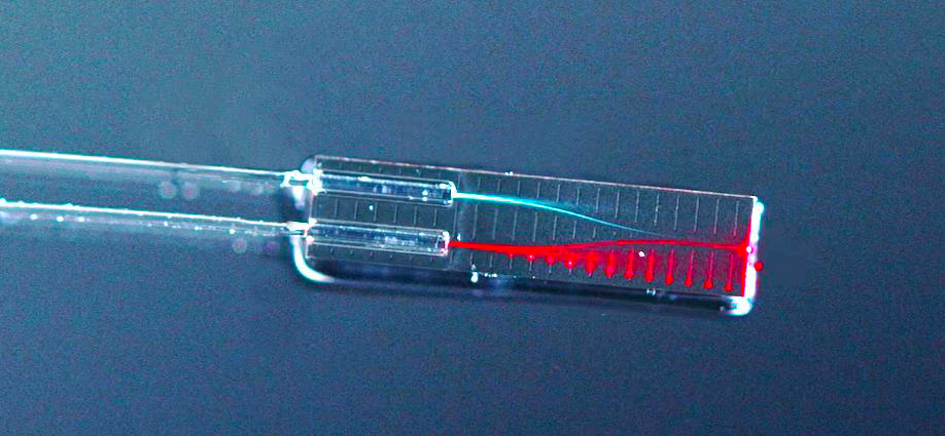
The “PolyChrome Berlin” alliance, which brings together partners from science and business in the Berlin-Brandenburg region, has qualified for funding from the German Federal Ministry of Education and Research (BMBF). Starting in spring 2022, the participating partners will receive 9.2 million euros over the next three years as part of the “RUBIN – Regional Entrepreneurial Alliances for Innovation” funding program. PolyChrome Berlin was able to prevail against a total of 53 applicants as one of eleven funded projects in the funding call.
“In the predecessor project PolyPhotonics Berlin, we were already able to develop miniaturized hybrid optical components for applications in telecommunications,” says Crispin Zawadzki, deputy group leader “Hybrid PICs” at Fraunhofer HHI and chairman of the PolyPhotonics Berlin e.V. association. “Based on this success, we are now expanding our research to the field of visible light in order to bring forth new applications in the fields of analytics and sensor technology. We are very pleased that we could continue to collaborate with the partners we know from PolyPhotonics Berlin e.V. and at the same time expand the project team.”
“When we talk about platform here, you have to imagine chips the size of a one-cent coin,” explains Arne Schleunitz, coordinator of the PolyChrome project and technical managing director of micro resist technology GmbH. “The small platform is equipped with optical waveguides made of polymer or SiN material and other functional elements, such as glass fibers. In addition, the surface of the chip can be provided with biological scavenger molecules (aptamers) for applications in medicine.”
The capabilities of the PolyChrome platform will be demonstrated using six demonstrators divided into three areas. The first area is the use of fiber-based sensing in the application field of fiber optic networks. Here, optical fibers can be used to monitor the environment, for example road traffic, as sensors. The second area comprises visible light sources, so-called multi-lambda sources. These are intended to open up products in the consumer sector such as RGB sources or to be used as light sources in medicine or research. The third area is the use of SiN sensors. SiN sensors enable fast, cost-effective and specific measurement of a wide range of chemical and biological substances. With this method, water bodies can be tested for pollutants within minutes or the body can be examined for vitamin insufficiencies.
The “Hybrid PICs” research group of the “Photonic Components” department at Fraunhofer HHI brings together the various components and thus provides the basis for the hybrid integration platform. The researchers are contributing their many years of experience in the manufacture of photonic components and technology platforms.
As part of the project, PolyChrome Berlin will develop a hybrid photonic integration platform. The innovative platform will be able to guide and deflect light as well as generate and detect it. The research team is using the platform to tap into a wide wavelength range from 400nm to 1650nm, ranging from infrared to visible light. The team is also working on an interplay between polymer- and silicon nitride-based optical waveguides. This novel approach combined with the platform’s hybrid integration capabilities will enable PolyChrome Berlin to open up new applications in sensing and analytics that can also be implemented cost-effectively.
“In the predecessor project PolyPhotonics Berlin, we were already able to develop miniaturized hybrid optical components for applications in telecommunications,” says Crispin Zawadzki, deputy group leader “Hybrid PICs” at Fraunhofer HHI and chairman of the PolyPhotonics Berlin e.V. association. “Based on this success, we are now expanding our research to the field of visible light to bring forth new applications in the fields of analytics and sensing. We are very pleased that we could continue to collaborate with the partners we know from PolyPhotonics Berlin e.V. and at the same time expand the project team.”
“When we talk about platform here, you have to imagine chips the size of a one-cent coin,” explains Arne Schleunitz, coordinator of the PolyChrome project and technical managing director of micro resist technology GmbH. “The small platform is equipped with optical waveguides made of polymer or SiN material and other functional elements, such as glass fibers. In addition, the surface of the chip can be provided with biological scavenger molecules (aptamers) for applications in medicine.”
The performance of the PolyChrome platform will be demonstrated on six demonstrators, which are divided into three areas. The first area is the use of fiber-based sensor technology in the application field of fiber optic networks. Here, optical fibers can be used to monitor the environment, for example road traffic, as sensors. The second area comprises visible light sources, so-called multi-lambda sources. These are intended to open up products in the consumer sector such as RGB sources or to be used as light sources in medicine or research. The third area is the use of SiN sensors. SiN sensors enable fast, cost-effective and specific measurement of a wide range of chemical and biological substances. With this method, water bodies can be tested for pollutants within minutes or the body can be examined for vitamin insufficiencies.
The “Hybrid PICs” research group of the “Photonic Components” department at Fraunhofer HHI brings together the various components and thus provides the basis for the hybrid integration platform. The researchers contribute their many years of experience in the production of photonic components and technology platforms.
With their core competencies, the 12 partners cover the entire value chain necessary for the development of the technology platform and its commercial exploitation. In addition to Fraunhofer HHI, the research project includes ADVA Optical Networking SE, Allresist GmbH, Chembio GmbH, Eagleyard Photonics GmbH, ficonTECService GmbH, Fraunhofer IZI-BB, Laser Zentrum Hannover e.V., micro resist technology GmbH, OSRAM Opto Semiconductors GmbH, Scienion AG and VPIphotonics GmbH.
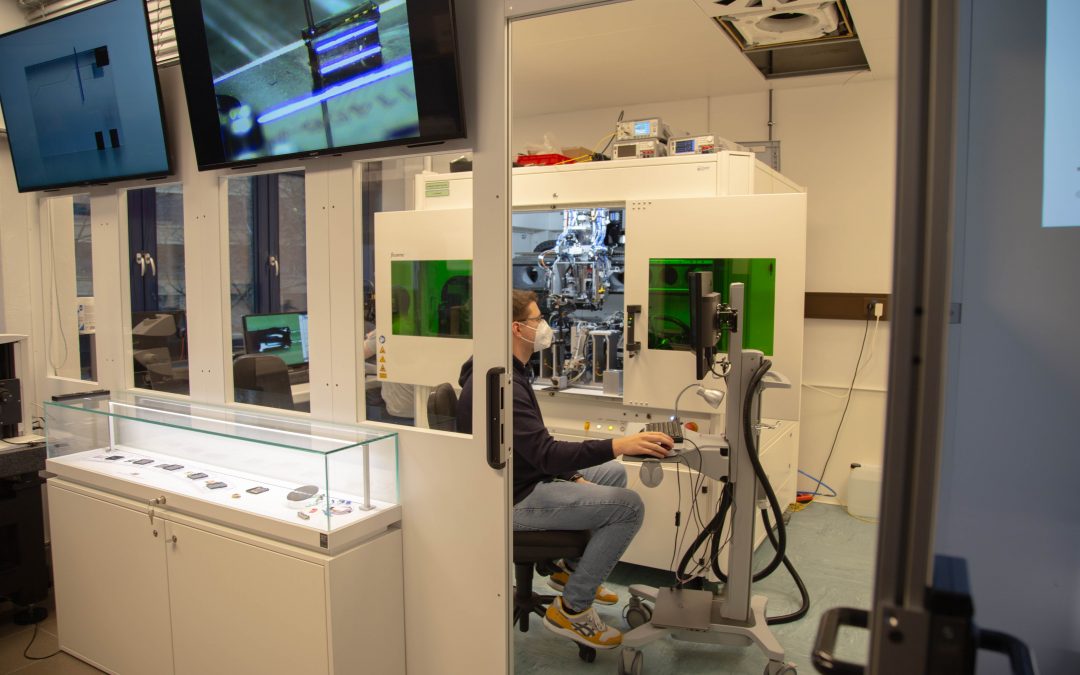

Under the coordination of micro resist technology GmbH, a consortium of 12 partners successfully applied for a concept phase with the joint project “PolyChrome Berlin – Photonic Integration Platform for Sensory and Analytical Applications in a Wide Wavelength Range – Berlin” within the framework of the call for proposals “RUBIN – Regional Entrepreneurial Alliances for Innovation” of the Federal Ministry of Education and Research.
The RUBIN alliance PolyChrome Berlin is dedicated to one of the most important key technologies and future industries of photonics by establishing a technology platform for the realization of hybrid optical components, which will find application for example in sensor technology or analytics. These innovative photonic components are technological prerequisites not least for the comprehensive digitization of society and Industry 4.0.
With PolyChrome Berlin, a hybrid photonic integration platform is being developed with which a wide range of novel applications from the field of sensor technology and analytics can be realized cost-effectively and compactly. The development of a wide wavelength range from 400nm -1650nm, as well as the interaction of polymer- and silicon nitride-based optical waveguides in combination with the hybrid integration capability forms the basis for this. The performance of the PolyChrome platform will be demonstrated on six demonstrators.
Around the medium of light, a high-tech branch with global appeal has emerged in the capital region of Berlin-Brandenburg. Here the alliance PolyChrome-Berlin wants to create further unique selling propositions for the region and open up new potentials. The alliance is already intensively anchored in the region. For example, a regional network with 126 members exists for the photonics sector. Against this background, sustainable processes can be developed and established to support a structural change.
The core competencies of the 12 partners from the RUBIN alliance PolyChrome cover the entire value chain necessary for the development of the technology platform and its commercial exploitation. The PolyChome RUBIN alliance includes:
Website: BMBF: Innovation & Strukturwandel
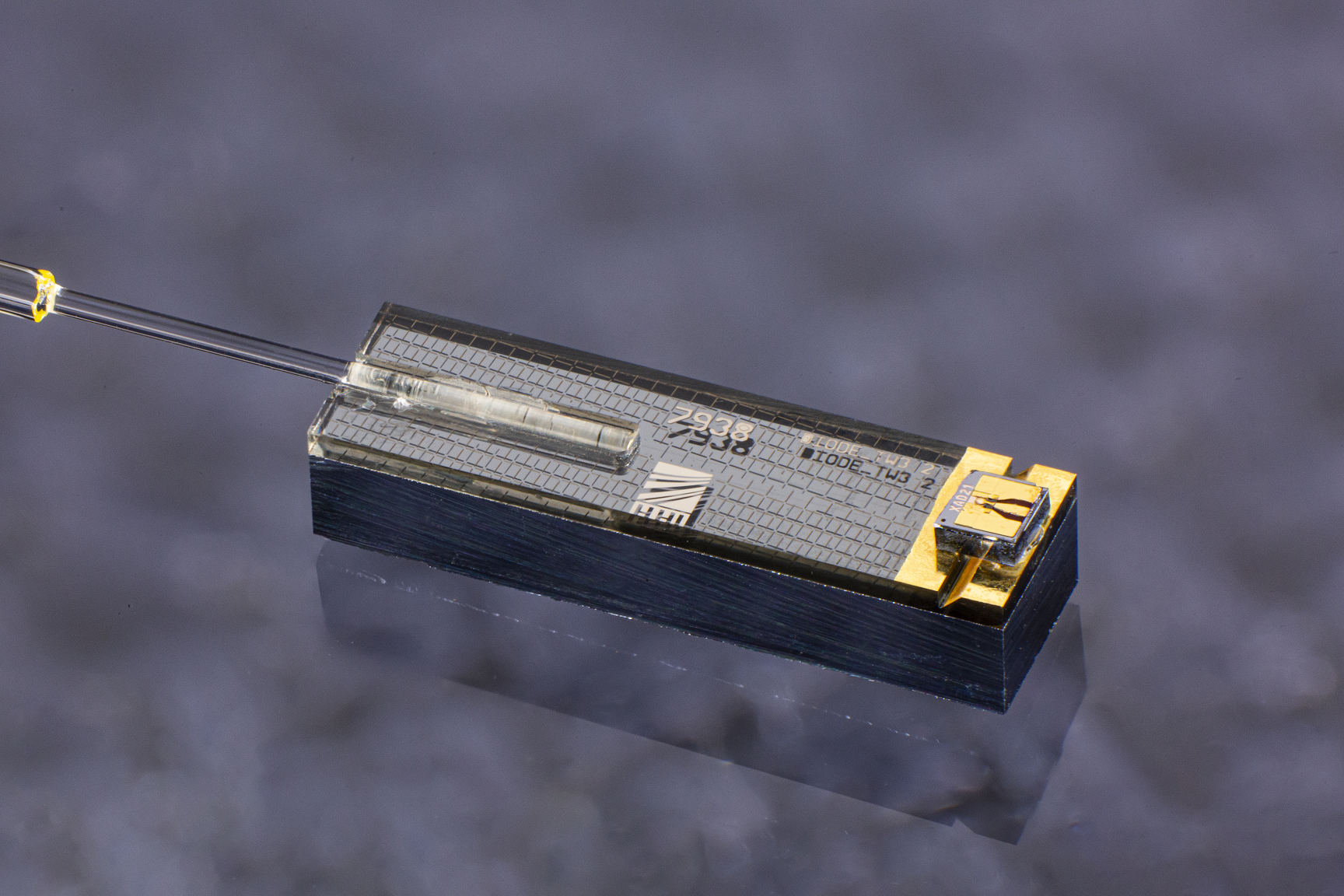
As a conclusion of three successful project years and with the foundation of PolyPhotonics e.V., the association presents itself in a short image film with the highlights of the past years.